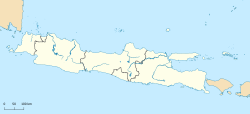 Front view of Indonesian Railway Museum (2019) | |||||
| General information | |||||
| Location | Jl. Stasiun, Panjang, Ambarawa, Semarang Regency Central Java Indonesia | ||||
| Coordinates | 7°15′56″S110°24′05″E / 7.265424°S 110.401359°E | ||||
| Elevation | +474.40 m (1,556.4 ft) | ||||
| Owned by | Kereta Api Indonesia | ||||
| Operated by | Kereta Api Indonesia | ||||
| Line(s) | | ||||
| Platforms | single island platform | ||||
| Tracks | 4 | ||||
| Construction | |||||
| Structure type | Ground | ||||
| Parking | | ||||
| Accessible | | ||||
| Other information | |||||
| Station code | ABR • 3306 [1] | ||||
| Classification | Class II [1] | ||||
| History | |||||
| Opened | 21 May 1873 [2] | ||||
| Closed | 8 April 1976 [3] | ||||
| Previous names | Willem I Station | ||||
| |||||
 Interactive map | |
| Established | 6 October 1976 [4] |
|---|---|
| Location | Jl. Stasiun, Panjang, Ambarawa, Semarang Regency, Central Java, Indonesia |
| Coordinates | 7°15′56″S110°24′05″E / 7.265424°S 110.401359°E |
| Type | Railway museum |
| Owner | Kereta Api Indonesia |
The Ambarawa Railway Museum (Indonesian : Museum Kereta Api Ambarawa, officially named Indonesian Railway Museum by the Indonesian Railway Company) is a museum located in Ambarawa in Central Java, Indonesia. The museum preserves around 21 steam locomotives and focuses on tourism train tours hauled by 3 operational steam engines (both are rack locomotives and a 4-4-0 two-cylinder compound steam engine) and a hydraulic diesel engine, using the remains of the closing of the 3 ft 6 in (1,067 mm) railway line.





































